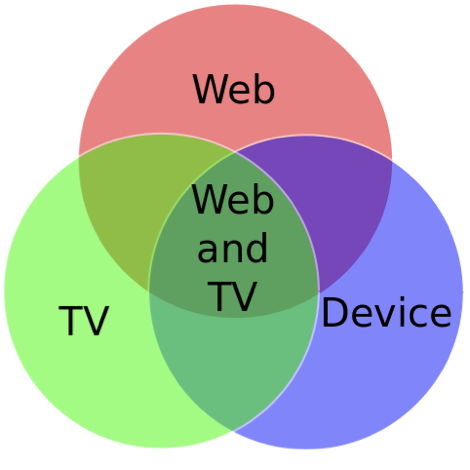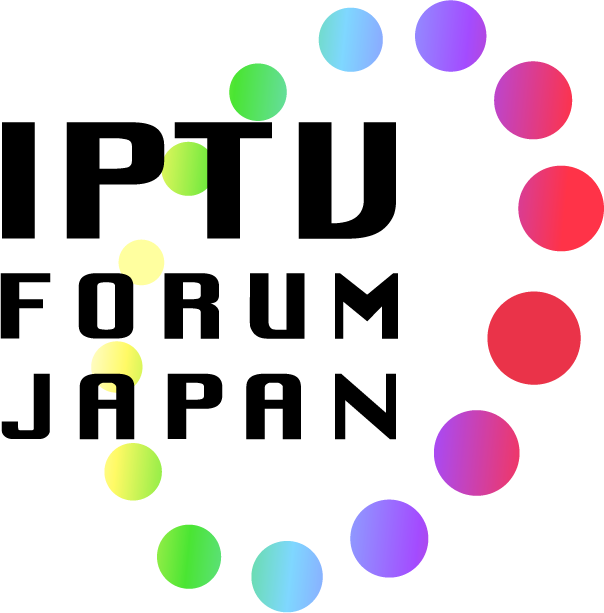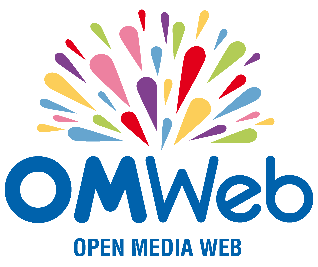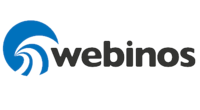Workshop summary
The workshop took place in February 2011. Please check the following pages for more details on topics that were discussed:
- Workshop agenda (speaker slides are linked from the agenda)
- Workshop summary
- Minutes day 1
- Minutes day 2
- List of papers
- List of participants
W3C issued a press release on 28 March 2011, following the publication of the workshop summary.
See the companion Workshop summary for details. The complete proceedings of the Workshop (PDF, 20.6MB) are also available in a single file.
Objectives
Evolution of Web technologies. The explosion of the mobile device market demonstrates how consumers have come to expect and rely on access to the network from anywhere, at any time, including from mobile computers, phones, automobiles, and more. Though consumers do not yet have the same expectations about their televisions, the situation is to change in the near future given the emergence of "connected TVs", the importance of television in people's lives, ongoing display and feature improvements, better interaction between TV and other devices, and the opportunity for new services created by increased connectivity, such as:
- use the TV as central hub to control other home devices
- support for VoD (Video on Demand) delivered through a broadband connection
- support for video conference, chat and "social" applications
- the ability to purchase through the Internet items advertised during a commercial
There are significant business opportunities in rising to the challenge of satisfying this desire for connectivity and ensuring that people have access to the Web from their televisions.
Possible benefits of Web technologies to broadcasting. Indeed, the convergence of Web technology and broadcasting has already begun. For instance, IP-based television is growing more popular, many countries have begun to recognize the importance of broadband access to their citizens, and many televisions run applications that are partially based on Web or Web-like technologies. Many in the IT industry view these as important transitional steps that can enable a wide new range of interactive services, well-integrated with the Web. The time is thus ripe for the television industry to help ensure this integration can be accomplished in a way that meets the needs of the industry. W3C has shown that people value "One Web" — available to anyone, anywhere, on any device — and the value of open and global Web standards, which lower implementation costs and simplify deployment of new applications. With convergence on the horizon, this is now a good opportunity to discuss the application of this approach to other industry areas such as television service providers.

Why this workshop? The IT industry is building the future Web platform at W3C. HTML5, CSS, SVG, and other open global standards for Web technology are starting to be deployed in browsers, and the Web community is enthusiastic about host of new features such as location-based services. W3C is organizing this workshop to bring the television industry and other producers of consumer electronics into the discussion. Participants in this workshop will have the opportunity to share their own perspectives, requirements, and ideas to ensure that emerging global standards meet their needs.
Participants in this workshop will share insights on topics such as the advantages of supporting HTML5 (such as its rich feature set, global language support, and support for accessibility), compatibility with existing television technology, performance issues, the transition from existing approaches to Web-based ones, digital rights management, nomadic user interfaces (where users change devices without losing the flow of their activity), and more.
This Second W3C Web and TV Workshop is a follow-up of a workshop held in Japan in September 2010. It will serve to continue the discussions at that workshop (see summary of the workshop, minutes, the workshop agenda (including talk slides) and the position papers submitted). A W3C Interest Group on "Web and TV" is currently being created (see draft charter), and the results of the second workshop will be fed into the work of this interest group.
The workshop also aims at expanding the already existing community of interested parties created after the Japan workshop (mailing list archive), with a view to defining the charter of possible W3C Working Groups or Incubator Groups on the topic.
Topics Of Interest
The main topics of interest for the envisioned workshop contributions include, but are not limited to the following:
State of the Art
- Demonstrating the advantages of Web-based broadcasting system
- Relationship between existing broadcasting systems and W3C/non-W3C Web standards
- The role of Web-based broadcasting approaches for improving the quality and reducing cost
- The role of Web-based approaches for nomadic user interfaces where users switch devices in the midst of using an application
- Survey of existing work in Web-like technology for TV services
HTML5 and TV
- Feedback from companies/specification groups using or planning to use Web technologies in their products/specifications on potential limitations in current W3C specifications (e.g. support of broadcast video using <video> element)
- Role of profiling HTML5/CSS for TV sets
- Methods to enforce compliance and interoperability (testing), e.g. for CE devices
- Plans to support HTTP adaptive streaming
- Plans to support Web-based technologies, e.g., HTML5, what kind of additional standards are needed
Standardization Needs
- A survey of current and future deployment of technologies integrating Web technologies and broadcasting technologies to determine W3C's potential role
- Requirements for extensions to the existing standards, e.g., HTML, to improve the support of broadcasting on various non-PC devices
- Standardization of Web-based frameworks for the development of broadcasting system
- Standardization of the semantics and syntaxes (e.g. XML syntaxes) of possible Web-based broadcasting system
Accessibility
- Accessibility of Web and TV technology (in particular in light of existing regulation on accessibility for TV technology)
- Value provided by Web technology for TV accessibility
Hot Topics
- Integrating P2P and the Web for TV content distribution
- Role of DRM for Web and TV (inclunding overview of ongoing work on interoperable and open DRM systems that work accross devices)
- (Micro-) Payment for Web and TV
- Support for "second screen" scenarios
Who Should Participate
The workshop is aimed at companies and organizations interested in the standardization of smarter integration of existing W3C standards, broadcasting technologies and non-PC device technologies.
You should consider participating in this workshop if you are in one of the following communities:
- TV broadcasters and TV service providers
- TV and set-top boxes manufacturers
- Companies that own solutions for the development of broadcasting, Web+TV and integration of them
- Companies seeking to exploit integration of broadcasting and Web technologies
- TV related software vendors or open source projects that currently offer XML-based languages for the description of handling broadcasting, or customers of those languages
- Government organizations seeking to standardize the integration of broadcasting and Web technologies
- Academic researchers with an interest in smarter integration of Web technologies, broadcasting and non-PC devices
How to Participate
To ensure productive discussions, the workshop is limited to 80 attendees. Participation is open to non-W3C members. Each organization can provide at most two attendees.
Position papers are required in order to participate in this workshop. Each organization or individual wishing to participate must submit a position paper explaining their perspectives on the workshop topic no later than 7 January 2011. The intention is to make sure that participants have an active interest in the area, and that the workshop will benefit from their presence.
Position papers should:
- Explain the participant's perspective on the topic of the Workshop
- Explain their view point
- Include concrete examples of their suggestions
See the position papers submitted for the first workshop to see what a position paper generally implies.
The Program Committee will ask the authors of particularly salient submissions to explicitly present their position at the workshop to foster discussion. Presenters will be asked to make the slides of the presentation available on the workshop home page in HTML, PDF, or plain text. See the agenda of the first workshop for what types of papers were selected for presentation.
Position papers should be written in English. All submissions should be 1 to 5 pages in length, although they may link to longer versions or appendices. Allowed formats are valid (X)HTML (please use the W3C validator), PDF or plain text.
Papers should be 1 to 5 pages in length. We are using EasyChair to manage the submission and review process. For all submissions please go to the Web+TV-2 page on EasyChair and click on the "New Submission" link. If you do not have an EasyChair account, you will need to create one here.
Position papers will be published on the public Web page of the workshop. Submitting a position papers comprises a default recognition of these terms for publication.
To attend, you must register by filling out the registration form. The URI for the registration form will be sent to you after your position paper is accepted.
Participation fee is €150 per participant to cover for food and other expenses.
See Section "Important dates" for submission and registration deadlines.
Workshop Organization
The Chairs and Program Committee will review position papers to select which people to invite to give presentations, and to come up with the workshop agenda.
Schedule:
The workshop program will run from 9 am to 5 pm on both days.
Venue:
The workshop will be held at the Fraunhofer Institute for Open Communication Systems FOKUS, Berlin, Germany.
Kaiserin-Augusta-Allee 31
10589 Berlin
Germany
From airport to Fraunhofer Institute FOKUS
The airport Flughafen-Tegel is located approx. 5 km from FOKUS. Take the express bus (line X9) to bus stop S+U-Bhf Jungfernheide and change there to bus line M27 (direction S-Bhf Pankow). Bus stop is Goslarer Platz. The Institute is directly in front of the bus stop. Taxi from the airport should cost 10 EUR (one way).
The airport Flughafen-Schönefeld is located approx. 30 km southeast from the center of the city. The S-Bahn service S9 and the Airportexpress (Regionalbahn) will bring you to the station Berlin Hauptbahnhof (around 40 minutes). At Hauptbahnhof please follow the description given below. Taxi should come close to 45,00 EUR.
By train
At Berlin Hauptbahnhof (main station) take the Expressbus TXL (direction: Airport Berlin Tegel) to the stop at Turmstraße/Beussel-straße. Change to bus M27 (direction: S+U Bahnhof Jungfernheide) and get out at Goslarer Platz.
By car
Take the Autobahn 115 (Avus) from Hanover, Leipzig, Nuremberg or the A 100 and at the junction follow the signs to Charlottenburg, then take the exit at Spandauer Damm, turn right, go straight ahead. After passing the Schloss Charlottenburg turn left over Luisenplatz and Mierendorffstraße (right) to Mierendorffplatz (right) into the Kaiserin-Augusta-Allee till you get to Goslarer Platz.
Alternatively, you may take the A 115 or A 111 until you reach the motorway interchange Autobahndreieck Charlottenburg, take the exit for Jakob-Kaiser-Platz onto the Tegeler Weg, turn left into the Osnabrücker Straße and follow it to its end, then cross over Mierendorffplatz into the Kaiserin-Augusta-Allee and follow it until you reach Goslarer Platz.
See also how to reach Fraunhofer-FOKUS
A list of recommended hotels is available.
Registration
See registration link.
Photo credit: Berlin Panorama by lunamtra, some rights reserved.
Call for Participations prepared by:
Francois Daoust, W3C; Philipp Hoschka, W3C; Giuseppe Pascale, Opera, Stephan Steglich, Fraunhofer FOKUS.
$Id: Overview.html,v 1.151 2011/07/27 20:43:38 fd Exp $




